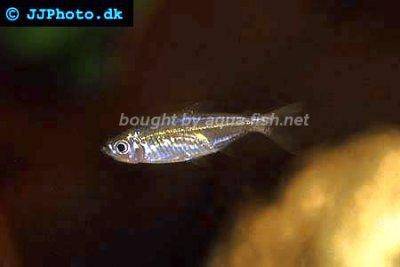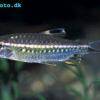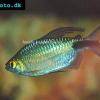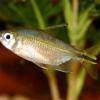Yellowtail tetra - Alestopetersius caudalis
Scientific name: Alestopetersius caudalis
Common name: Yellowtail tetra
Family: Alestidae
Usual size in fish tanks: 5 - 7 cm (1.97 - 2.76 inch)
014
Recommended pH range: 6.8 - 7.9
Recommended water hardness: 10 - 20°N (178.57 - 357.14ppm)
0°C 32°F30°C 86°F
Recommended temperature range: 22 - 25 °C (71.6 - 77°F)
The way how these fish reproduce: Spawning
Where the species comes from: Africa
Temperament to its own species: peaceful
Temperament toward other fish species: peaceful
Usual place in the tank: Top levels
Diet and Feeding Habits
Yellowtail Tetras are omnivorous, accepting a variety of foods with ease. For their main diet, offer high-quality flake food to ensure they receive the necessary nutrients. To enhance their diet and promote vibrant health, supplement with live or frozen foods such as brine shrimp, daphnia, and bloodworms twice a week. Occasionally, you can introduce vegetable-based foods like spirulina flakes or blanched vegetables to offer a well-rounded diet that mimics their natural feeding habits in the wild.
Natural Habitat and Distribution
Native to the freshwater systems of Africa, Yellowtail Tetras are primarily found in the Congo River Basin. This region is known for its diverse aquatic life and consists of slow-moving waters with dense vegetation. In their natural habitat, these tetras thrive in soft, slightly acidic to neutral waters with plenty of hiding spots and plants. When keeping them in an aquarium, replicating this environment is essential for their well-being.
Sexing: Identifying Male and Female Yellowtail Tetras
Distinguishing between male and female Yellowtail Tetras can be challenging, especially when kept in groups. However, males generally display more intense coloration, particularly in their yellow-tipped tails and fins, while females tend to have a slightly rounder body. Observing their behavior and coloration during mating season can help differentiate the sexes.
Breeding Challenges
Breeding Yellowtail Tetras is notoriously difficult, even for experienced aquarists. To improve chances of success, provide a well-planted breeding tank with fine-leaved plants for the female to scatter her eggs. Condition the parents by feeding them live foods for at least two weeks before introducing them to the breeding environment. Once eggs are scattered, immediately remove the parents to prevent them from consuming the eggs. Proper water conditions and a peaceful, quiet environment are crucial for successful hatching.
Lifespan
With proper care, Yellowtail Tetras can live between 8 and 10 years in captivity, making them a long-term commitment for dedicated aquarium keepers.
General Care and Behavior
Yellowtail Tetras are hardy and adaptable, capable of tolerating a range of water conditions. They are peaceful by nature and do best when kept in schools of at least 5-6 individuals. In the aquarium, they thrive in well-planted tanks with subdued lighting that mimics the dimly lit waters of their native habitat. Their vibrant colors and calm demeanor make them a great addition to community tanks, provided they are kept with similarly peaceful species.
Pictures
Bought by aqua-fish.net from jjphoto.dk.



 Red
Red  African
African  Longfin
Longfin  Congo
Congo